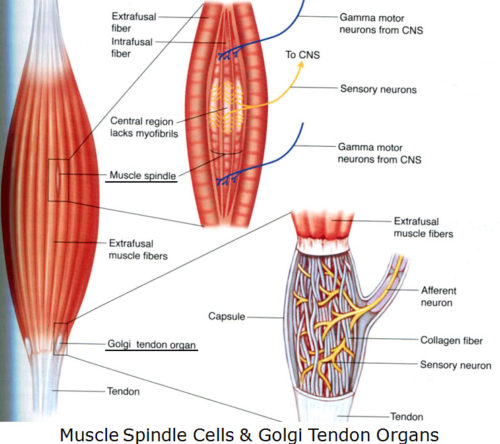Muscle Balancing and Joint Stabilization
Muscles and tendons can be weak for many reasons, even in athletes and bodybuilders. If there is an imbalance around a joint, where the muscles on one side (like the biceps) are much stronger than the muscles on the other side (like the triceps), the stronger muscles have to work harder to pick up the slack, creating even more imbalance.
As a result, some muscles get hypertonic – excess tone from prolonged contraction and shortening of the muscle, tendon, and fascial fibers. You probably see clients with such hypertonic muscles every day on your table.
As some muscles get overly contracted, other muscles can get overly stretched. The neuromuscular spindle cells are constantly on the lookout for overly contracted muscles. When they detect that, they send a signal to the brain which in turn sends a signal to those muscles to go weak.
This is a built-in protection mechanism. An example of this is when you pick up something very heavy, and after you struggle with it for a few moments you have to put it down or drop it.
The golgi tendon organs, on the other hand, look for muscles that are overly lengthened or stretched, which creates a different sort of tension. When they detect that, they also send a signal to the brain which instructs that muscle to go weak. This helps to prevent tearing of the muscle fibers.
When some parts of muscles, tendons, and fascia are chronically weak, there is reduced blood flow, lymphatic flow, and nerve conduction that can get through the joint. And the fascia in and around the joint often gets dehydrated, causing restrictions in the joint, reduced ROM, and often pain.
In the Muscle Balancing and Joint Stabilization class, you learn how to quickly find where these weaknesses are and how to use techniques that quickly minimize those fascial restrictions in the joint, allowing increased blood flow, lymphatic flow, and nerve conduction.
The result is that the dormant parts of muscles, tendons, and fascia are “switched back on”, firing on all cylinders. This allows you to work, play, and do what you want to do with less chance of injury and pain. Also, the stronger muscles don’t have to work so hard to maintain balance. So, they’re easier to loosen when they’re on the table.

